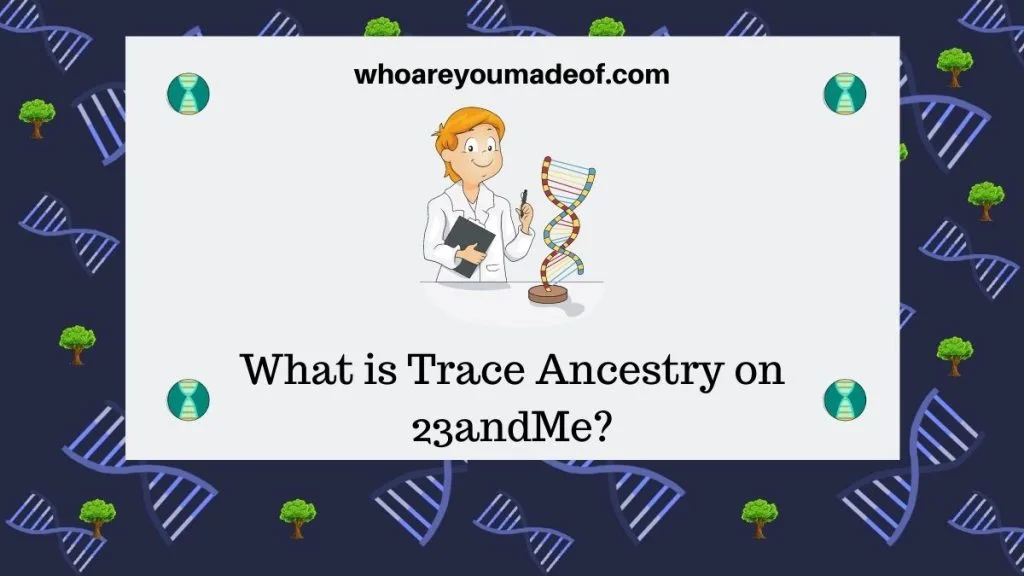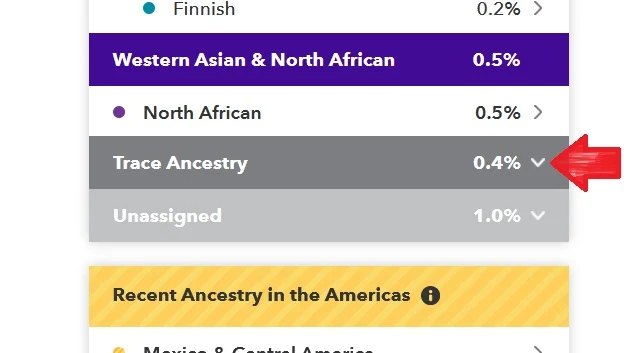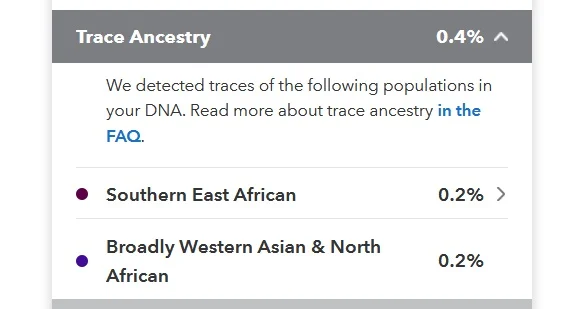Have you seen your trace ancestry regions on 23andMe? In this post, learn what trace ancestry is and how to learn more about your ancestors from those areas.
To many people, trace ancestry is the most exciting aspect of their DNA results. The trace regions are the most likely the ones that surprise us and lead us to imagine our distant ancestors who lived in those places.

Most people have a general idea of where their most recent ancestors were from. At the very least, we usually know who our parents and grandparents were, and the continent upon which their ancestors lived.
The trace regions, however, are exciting. They are, too, a source of mystery.
Below, we'll discuss exactly what it means to have trace ancestry on your 23andMe Ancestry Composition report and how you might be able to discover who your trace ancestors were.
What does trace ancestry mean on 23andMe?
Any region that matches your DNA at .1% or more will show up on your 23andMe results. Put simply, trace ancestry means that the 23andMe software detected only a very small portion of your DNA as matching your trace region.
23andMe is a great company, and they feel pretty confident about the DNA results that they provide to us. When we find a trace ancestry region on our results, it is up to us to decide how meaningful the information is to us.
How to find your trace ancestry regions on 23andMe results
Your trace ancestry regions on 23andMe are located towards the bottom of your Ancestry Composition report. In order to view your trace regions, you must click the down arrow to expand the results.
In the image below, we see the down arrow next to the percentage of trace ancestry:

Once we have expanded the results, we see that this person has a total of .4% of their DNA showing up as "trace", with .2% matching the Southern East Africa region and .2% showing up as Broadly Western Asian and North Africa:

Note: If you have been assigned a country in the Recent Ancestry in the Americas, you will find your trace ancestry listed before this section.
You can click on most of the specific regions in your report to learn more about them, including many trace regions.
Is trace ancestry wrong?
Many people believe that the very small percentages matching trace regions means that those regions are incorrect.
While it is true that the smaller the percentage matching an area, the smaller the chance that your DNA really did come from that region, it doesn't mean that we should always ignore trace results.
How to know if your trace regions are correct?
While only family tree research combined with DNA results can tell us for sure where our ancestors came from, there are some clues that you can look for:
- Play with your confidence levels (read more about how to do it in this post: Is the 23andMe Ancestry Composition accurate?).
- DNA from regions neighboring the trace region (could mean an Irish ancestor with small amounts of Scottish DNA, for example)
- Lots of DNA matches from the region, or a neighboring region
- The trace region has shown up on multiple DNA results, if you have tested with more than one company
- Trace region matching your mtDNA or Y-DNA haplogroup
- Trace region shows up on Gedmatch Admixture Calculators
If you haven't already done so, definitely take advantage of your curiosity about your ethnicity estimate and trace regions and begin building a family tree. There is a lot of excitement in a family tree, I promise!
How to learn more about your trace regions on 23andMe
One of the things that I love about 23andMe DNA results is the sheer amount of information and detail that we are provided. Trace ancestry is just one of those small details that really gives us amazing access to the data in our genome.
Another great example of the information access we get at 23andMe is the ability to view and even download data about the DNA segments on specific chromosomes that match the regions on our results.
This kind of access to information is enough to make a girl like me stay up all night!
However, it does mean that we sometimes have to work a bit extra to make sense of the extra details we learn about the DNA that we inherited from our ancestors. Below are some ideas that you can use to learn about your trace ancestry regions:
- Learn about chromosome mapping techniques (like DNA Painter)
- Research how to use DNA matches to build your family tree
- Read about the history and migration events/patterns between places where you know your ancestors lived and your trace regions
There is so much to learn about your unique family history, and your trace regions are a very interesting piece to the puzzle.
Conclusion
I hope that this post has helped you understand more about your trace ancestry results on 23andMe, including how to learn more about how these regions may have ended up in your DNA results.
If you have any questions about something that you read in this post, or about a specific trace region on your results, I would love to hear from you in the discussion below.
Thanks for stopping by today!


George
Friday 14th of October 2022
I think ancestry DNA services are falling victim to one of the same problems seen in forensic DNA analysis; as the technology advances to analyze ever smaller samples, distortions are increasing with more intensive amplification, leading to less concrete and more speculative results.
Anthony Flynn
Tuesday 24th of May 2022
Interesting as I am 97 percent British and Irish with Trace ancestry percent 0.3 from Egypt Byzantine And Levantines. Strange eh, so far from The British isles